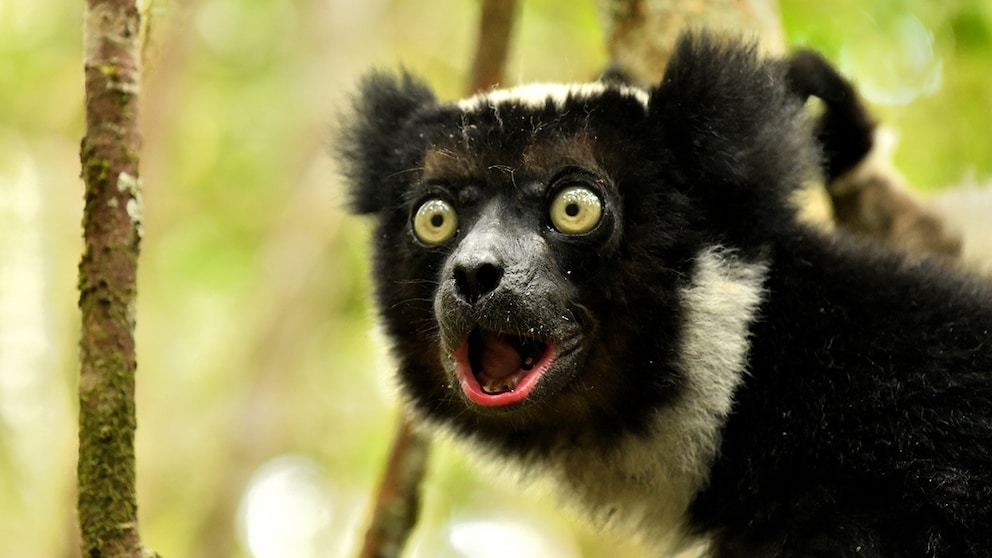April 10, 2025, 3:45 pm | Read time: 4 minutes
Even in the animal kingdom, the first attempt at singing often sounds wrong: a new study shows that young indris — Madagascar’s singing lemurs — first have to learn to control their voice, just like human children. Why is this the case, and what does it tell us about the evolution of singing?
Have you ever heard children sing? Then you probably know that they often don’t hit the right notes straight away. They still have to practice using their vocal cords. This also seems to apply to young lemurs in Madagascar, as a recent study led by Dr. Chiara De Gregorio from the University of Warwick shows that Indris, one of the many lemur species, sing much more discordantly in their youth than in adulthood. The findings provide exciting evidence of an evolutionary link between human and animal vocal behavior.
Can Lemurs Really Sing?
In biology, singing is defined as a vocalization that lasts for a certain period of time and has a complex structure.1 Birds are probably the most famous example of this. But other animals, such as frogs, whales, and crickets, also “sing.” Not all of them use their vocal cords for this, and we humans would not always describe the sounds they make as singing.
Even the singing of the indris, a special species of lemur, sounds more like screaming to most people. The lemurs native to Madagascar sing in groups to demarcate territory, communicate within the family, and strengthen social bonds. Their singing is complex and melodious — but by no means always harmonious.
However, Dr. Chiara De Gregorio and her team have already discovered in recent years that the calls of lemurs have a regular rhythm, known as isochrony, which is similar to music. The Indris have such a large number of so-called vocal rhythms that they even outperform songbirds. No wonder they are also known as “Madagascar’s singing lemurs.” 2
Why Young Lemurs Sing “Off-Key”
But before lemurs become gifted singers, they have to practice a lot. The animals start practicing at a young age. And just as small children often struggle to hit the right notes and sing melodies, young Indris also have to learn how to use their voices correctly. But how do the researchers know that the lemurs sing off-key? After all, to the human ear, the singing sounds more like screaming and less like a melody.
If the lemurs sing off-key, there are tonal deviations. These are manifested by tone breaks, harsh sound components, and sudden jumps in pitch. Scientists also refer to these as non-linear phenomena — NLP for short. The fact that these occur primarily in young animals has now been comprehensively proven for the first time.
“In this analysis of 62 wild indris and over 16,000 vocal notes, we found that young indris produce significantly more NLPs than adult animals,” explained Dr. Chiara De Gregorio, Postdoctoral Research Fellow at the University of Warwick and lead author of the study in a press release from the university. This suggests that singing in unison is an evolving skill.
Male Lemurs Sing More Harshly
In addition to age, gender also plays a role in the development of vocal characteristics. The study revealed that male Indris tend to sing more harshly and unstably than females. This could be due to the lemurs’ gender-specific social roles. A rough voice and irregular sound patterns could, for example, serve to make the singer appear larger or more threatening.
However, it was not only young lemurs that sang off-key: the NLPs were also found in adult animals — and particularly frequently at the end of longer vocal phrases. This could be an indication that lemurs can also become vocally fatigued and thus represent a further parallel to human singing. After all, the voice of human singers also loses strength after a longer performance.

The different sounds and songs of budgies and what they mean

This Musician Sings for Animals and Became an Internet Star

7 Exciting Facts About Corvids
An Evolutionary View of Singing
The study was published in the journal Philosophical Transactions of the Royal Society B. Their findings go far beyond the acoustic characteristics of the Indris: they show astonishing parallels to human singing and provide new clues as to how musical and linguistic forms of expression may have developed in primates — and ultimately in humans. They also show that practice makes perfect, even in the animal kingdom!

